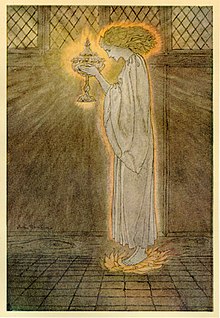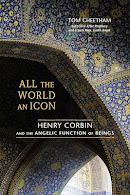"...the Imagination (or love, or sympathy, or any other sentiment) induces knowledge, and knowledge of an 'object' which is proper to it..."
Henry Corbin (1903-1978) was a scholar, philosopher and theologian. He was a champion of the transformative power of the Imagination and of the transcendent reality of the individual in a world threatened by totalitarianisms of all kinds. One of the 20th century’s most prolific scholars of Islamic mysticism, Corbin was Professor of Islam & Islamic Philosophy at the Sorbonne in Paris and at the University of Teheran. He was a major figure at the Eranos Conferences in Switzerland. He introduced the concept of the mundus imaginalis into contemporary thought. His work has provided a foundation for archetypal psychology as developed by James Hillman and influenced countless poets and artists worldwide. But Corbin’s central project was to provide a framework for understanding the unity of the religions of the Book: Judaism, Christianity and Islam. His great work Alone with the Alone: Creative Imagination in the Sufism of Ibn ‘Arabi is a classic initiatory text of visionary spirituality that transcends the tragic divisions among the three great monotheisms. Corbin’s life was devoted to the struggle to free the religious imagination from fundamentalisms of every kind. His work marks a watershed in our understanding of the religions of the West and makes a profound contribution to the study of the place of the imagination in human life.Search The Legacy of Henry Corbin: Over 800 Posts
Wednesday, November 30, 2011
Monday, November 28, 2011
Bishop Berkeley & Esoteric Traditions
The Other Bishop Berkeley: An Exercise in Re-Enchantment
Costica Bradatan
Costica Bradatan proposes a new way of looking at the influential a18th-century Anglo-Irish empiricist and idealist philosopher. He approache Berkeley's thought from the standpoint of its roots, rather than from how it has come to be viewed since his time. This book will interest scholars working in a wide variety of fields, from philosophy and the history of ideas to comparative literature, utopian studies, religious and medieval studies, and critical theory.
This other Berkeley read and wrote alchemical books, daydreamed of "Happy Islands" and the "Earthly Paradise" and depicted them carefully, designed utopian projects and spent years trying to put them into practice. Bradatan discovers a thinker deeply rooted in Platonic, mystical, and sometimes esoteric traditions, who saw salvation as philosophy and practiced philosophy as a way of life. This book uncovers a richer Berkeley, a more profound and spectacular one, and, it is hoped, a more truthful one.
Costica Bradatan
Costica Bradatan proposes a new way of looking at the influential a18th-century Anglo-Irish empiricist and idealist philosopher. He approache Berkeley's thought from the standpoint of its roots, rather than from how it has come to be viewed since his time. This book will interest scholars working in a wide variety of fields, from philosophy and the history of ideas to comparative literature, utopian studies, religious and medieval studies, and critical theory.
This other Berkeley read and wrote alchemical books, daydreamed of "Happy Islands" and the "Earthly Paradise" and depicted them carefully, designed utopian projects and spent years trying to put them into practice. Bradatan discovers a thinker deeply rooted in Platonic, mystical, and sometimes esoteric traditions, who saw salvation as philosophy and practiced philosophy as a way of life. This book uncovers a richer Berkeley, a more profound and spectacular one, and, it is hoped, a more truthful one.
| Costica Bradatan teaches philosophy at Texas Tech University and is Senior Editor of Janus Head: A Journal of Interdisciplinary Studies in Literature, Continental Philosophy, Phenomenological Psychology, and the Arts. |
Tuesday, November 22, 2011
Henry Corbin & the Secret of the Grail
Henry Corbin & the Secret of the Grail
by John Carey
is now in print in Temenos Academy Review 14
which may be ordered online here.
This important essay is based on the text of a lecture presented in Oxford and London for the Temenos Academy. The London lecture can be heard online at the Temenos Academy website here. Every student of Corbin should read this piece.
"Henry Corbin, one of the twentieth century's greatest scholars of the inspired Imagination, is best known for his studies of Shi'ite and Sufi spirituality; but his dedication to that dimension of reality which he called the mundus imaginalis led him to explore many other traditions as well. One theme which particularly captured his imagination was the image of the Grail. This lecture will look at what the Grail was for Corbin: at the versions of the story to which he refers, at the contexts in which he speaks of it, and at the hints of what he may have believed its essential significance to be."
[Also readers should note another essay by Carey which appears in Sacred Web 28: The Face and the Veil: Divine Presence and Mortal Absence in Fís Adomnáin and Nicholas of Cusa. The article focuses on two ideas discussed by the anonymous author of Fís Adomnáin (‘The Vision of Adomnán’), a Celtic account of the afterlife written around the end of the first Christian millennium: “the meeting of the eyes” and “the coincidence of contradictories”. Both these ideas, independently expressed in Nicholas de Cusa’s De visione Dei, and discussed in the later writings of Ananda K. Coomaraswamy, point to certain profound truths about the nature of Reality. ]
 John Carey
is a Statutory Lecturer in the Department of Early and Medieval Irish,
University College, Cork, Ireland, and a Fellow of the Temenos Academy.
His publications include King of Mysteries: Early Irish Religious Writings, A Single Ray of the Sun: Religious Speculation in Early Ireland, and Ireland and the Grail. A love of Arthurian legend drew him into Celtic studies early in life and has never left him.
John Carey
is a Statutory Lecturer in the Department of Early and Medieval Irish,
University College, Cork, Ireland, and a Fellow of the Temenos Academy.
His publications include King of Mysteries: Early Irish Religious Writings, A Single Ray of the Sun: Religious Speculation in Early Ireland, and Ireland and the Grail. A love of Arthurian legend drew him into Celtic studies early in life and has never left him.Monday, November 21, 2011
Mysticism at the Reitberg Museum, Zurich
The Rietberg Museum is proud to present the world's first culturally comparative exhibition on mysticism.
This elusive religious phenomenon will be illustrated by the example of forty male and female mystics: their lives and writings demonstrate just how richly varied spiritual experience can be. The mystics chosen for the exhibition come from the great religions of the world - Hinduism, Buddhism, Daoism, Islam, Judaism and Christianity - and span the period from the 6th century BC until the 19th century.
This elusive religious phenomenon will be illustrated by the example of forty male and female mystics: their lives and writings demonstrate just how richly varied spiritual experience can be. The mystics chosen for the exhibition come from the great religions of the world - Hinduism, Buddhism, Daoism, Islam, Judaism and Christianity - and span the period from the 6th century BC until the 19th century.
Among these remarkable mystics are a Tibetan ascetic, an
immortal from China, an unconventional Zen master, an abbot from
the monastery of Sinai, an uncompromising social revolutionary, an
ecstatic female poet from India, a Swiss hermit who used a stone as
his pillow, a Jewish scholar who searched for the hidden names of
God, and a Sufi poet intoxicated by love whose poems are among the
pearls of world literature.
Thanks to Steven Aftergood for drawing our attention to this.
Wednesday, November 9, 2011
Sunday, November 6, 2011
More Remembrances of James Hillman
Collected by Thomas Moore here: Remembering James Hillman across the web
Saturday, November 5, 2011
Friday, November 4, 2011
Todd Lawson in London - Frye & the Koran
On Wednesday 9 November Prof. Todd Lawson of the University of Toronto will give a lecture on the late Prof. Northrop Frye, under the title "Frye & the Koran." Frye, one of the pre-eminent literary critics of the second half of the 20th century, changed the way the world thought about the connections between spiritual vision, myth and literature, first through his study of Blake (Fearful Symmetry 1947), then later by his studies of the Bible (The Great Code 1982, Words with Power 1990 and The Double Vision 1991). The insights he developed over these decades offered a new perspective on the coherence and integrity of the Bible in which the workings of myth, metaphor and apocalypse create what can be called a spiritual dimension of time. In these works he also made scattered and frequently very perceptive remarks about the Koran, its form and content. Research into his private papers at the University of Toronto, where he taught all his life, shows that his interest in the Koran started long before his published studies of the Bible. A close look reveals an imaginative domain in Frye’s consciousness common to both sacred books where the idea of the spiritual is given clear and perhaps distinctive meaning. (from the Temenos Academy Newsletter)
At The Royal Asiatic Society, 14 Stephenson Way, London NW1 2HD (nearest underground Euston or Euston Square), doors open 6.30pm, lecture 7pm. An admission charge applies. Space is limited and reservation recommended.
At The Royal Asiatic Society, 14 Stephenson Way, London NW1 2HD (nearest underground Euston or Euston Square), doors open 6.30pm, lecture 7pm. An admission charge applies. Space is limited and reservation recommended.
Thursday, November 3, 2011
Subscribe to:
Posts (Atom)







